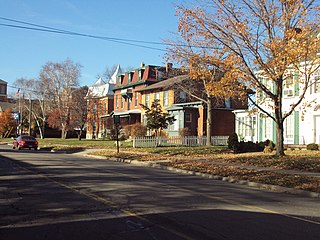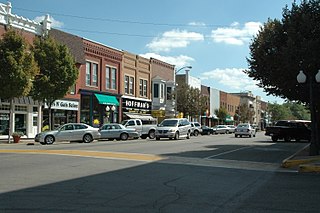
Wilmette is a village in New Trier Township, Cook County, Illinois, United States. Bordering Lake Michigan, it is located 14 miles (23 km) north of Chicago's downtown district and had a population at the 2010 census of 27,087. In 2020, Wilmette was ranked by Niche.com as the best place to raise a family in Cook County based on a variety of factors including public schools grade, percentage of residents with a bachelors degree or higher, crime & safety grade, family amenities, walkability grade, percentage of households with children, and access to parks and other recreational activities. Wilmette is also home to Romona Elementary School, a recent recipient of the National Blue Ribbon award bestowed by the U.S. Department of Education.

The Near South Side is a community area of Chicago, Illinois, United States, just south of the downtown central business district, the Loop. The Near South Side's boundaries are as follows: North—Roosevelt Road ; South—26th Street; West—Chicago River between Roosevelt and 18th Street, Clark Street between 18th Street and Cermak Road, Federal between Cermak Road and the Stevenson Expressway just south of 25th Street, and Clark Street again between the Stevenson and 26th Street; and East—Lake Michigan.

Prairie School is a late 19th- and early 20th-century architectural style, most common in the Midwestern United States. The style is usually marked by horizontal lines, flat or hipped roofs with broad overhanging eaves, windows grouped in horizontal bands, integration with the landscape, solid construction, craftsmanship, and discipline in the use of ornament. Horizontal lines were thought to evoke and relate to the wide, flat, treeless expanses of America's native prairie landscape.

The Sycamore Historic District is a meandering area encompassing 99 acres (400,000 m2) of the land in and around the downtown of the DeKalb County, Illinois, county seat, Sycamore. The area includes historic buildings and a number of historical and Victorian homes. Some significant structures are among those located within the Historic District including the DeKalb County Courthouse and the Sycamore Public Library. The district has been listed on the National Register of Historic Places since May 2, 1978.

The Frank Lloyd Wright/Prairie School of Architecture Historic District is a residential neighborhood in the Cook County, Illinois village of Oak Park, United States. The Frank Lloyd Wright Historic District is both a federally designated historic district listed on the U.S. National Register of Historic Places and a local historic district within the village of Oak Park. The districts have differing boundaries and contributing properties, over 80 of which were designed by Frank Lloyd Wright, widely regarded as the greatest American architect to have ever lived.
John Shellette Van Bergen was an American architect born in Oak Park, Illinois. Van Bergen started his architectural career as an apprentice draftsman in 1907. In 1909 he went to work for Frank Lloyd Wright at his studio in Oak Park. At Wright's studio he did working drawings for and supervised the Robie House and the Mrs. Thomas Gale House. Van Bergen designed prairie style homes in the Chicago area, mostly in the suburbs of Oak Park and River Forest. His home designs are recognized as excellent examples of Prairie style architecture and several are listed as local landmarks. A few of his homes are listed on the U.S. National Register of Historic Places.

The George W. Furbeck House is a house located in the Chicago suburb of Oak Park, Illinois, United States. The house was designed by famous American architect Frank Lloyd Wright in 1897 and constructed for Chicago electrical contractor George W. Furbeck and his new bride Sue Allin Harrington. The home's interior is much as it appeared when the house was completed but the exterior has seen some alteration. The house is an important example of Frank Lloyd Wright's transitional period of the late 1890s which culminated with the birth of the first fully mature early modern Prairie style house. The Furbeck House was listed as a contributing property to a U.S. federal Registered Historic District in 1973 and declared a local Oak Park Landmark in 2002.

The Oscar B. Balch House is a home located in the Chicago suburb of Oak Park, Illinois, United States. The Prairie style Balch House was designed by famous architect Frank Lloyd Wright in 1911. The home was the first house Wright designed after returning from a trip to Europe with a client's wife. The subsequent social exile cost the architect friends, clients, and his family. The house is one of the first Wright houses to employ a flat roof which gives the home a horizontal linearity. Historian Thomas O'Gorman noted that the home may provide a glimpse into the subconscious mind of Wright. The Balch house is listed as a contributing property to a U.S. federally Registered Historic District.

The Chicago and Northwestern Depot is a former railway station in Wilmette, Illinois, which has been on the National Register of Historic Places since 1975. The station served the Chicago and North Western Railway along what is now Metra's Union Pacific/North Line. It was built in 1873 as a passenger station and became a freight station in the 1890s before closing in 1946. The station was relocated to its current location on June 13, 1974, and it has since been remodeled as a restaurant. The depot has been called "Wilmette's most historic building," and the Chicago Sunday Times referred to the station as "the finest station on the entire line" upon its opening.

The East Elm–North Macomb Street Historic District is a residential historic district located in the city of Monroe in Monroe County, Michigan. The district was listed as a Michigan Historic Site and added to the National Register of Historic Places on May 6, 1982.

Prairie Avenue is a north–south street on the South Side of Chicago, which historically extended from 16th Street in the Near South Side to the city's southern limits and beyond. The street has a rich history from its origins as a major trail for horseback riders and carriages. During the last three decades of the 19th century, a six-block section of the street served as the residence of many of Chicago's elite families and an additional four-block section was also known for grand homes. The upper six-block section includes part of the historic Prairie Avenue District, which was declared a Chicago Landmark and added to the National Register of Historic Places.

The Oak Circle Historic District is a historic district in Wilmette, Illinois, United States. The district covers 2.6 acres (0.011 km2) and includes twenty-two contributing properties and four non-contributing properties, all located along Oak Circle. It primarily consists of fifteen single-family homes representative of the Prairie School and Craftsman styles of architecture. The Oak Circle Historic District was added to the National Register of Historic Places on June 21, 2001; it was the first historic district to be designated in Wilmette.
Antoine Ouilmette was a fur trader and early resident of what is now Chicago, Illinois. He was of French Canadian and possibly Native American ancestry. The village of Wilmette, Illinois is named in his honor.

The North Geneva Historic District is a set of 161 buildings and structures in Geneva, Illinois. Of those, 150 contribute to the district's historical integrity. The district was added to the National Register of Historic Places in 1979, and was slightly enlarged in 2017.

Eagles Mere Historic District is a national historic district in the mountain lake resort of Eagles Mere in Shrewsbury Township, Sullivan County, Pennsylvania. The resort area was founded in the late nineteenth century and popular through the first half of the twentieth century. It surrounds Eagles Mere Lake.

The Alfred Bersbach House is a John S. Van Bergen-designed house in Wilmette, Illinois. Built in 1915, it is reflective of the Prairie School approach to house architecture. Architectural historian Carl W. Condit and others considered the house to be Van Bergen's masterpiece.

The Ridge Historic District is a residential historic district in the Beverly and Morgan Park neighborhoods of Chicago, Illinois. As its name suggests, the district is centered on a ridge, making it one of the few areas of high ground in the generally flat city. Development in the district began in the late nineteenth century, as the Rock Island Line brought access to downtown jobs and several private schools opened in the area, and continued through the early twentieth century. Real estate atop the ridge was particularly sought after for its views and attracted wealthy residents, while the area's working-class population typically lived near the railroad stations. The district's houses exhibit a variety of popular architectural styles from its period of growth; its Prairie School architecture is especially noteworthy, including twelve designs by Walter Burley Griffin and multiple Frank Lloyd Wright works.

The East Ravenswood Historic District is a primarily residential historic district in the Ravenswood neighborhood of Chicago, Illinois. Constructed between 1880 and 1940, the buildings in the district include the first parts of Ravenswood to be developed. Ravenswood was one of Chicago's first suburban neighborhoods, and the area's many trees and proximity to the Chicago River appealed to residents looking for less urbanized surroundings. Transit connections, including the new Ravenswood branch of the Chicago 'L', and the growth of Chicago as a whole brought new residents and greater density to the neighborhood over the ensuing decades. The district is mainly composed of houses and small apartment buildings, the designs of which reflect the transition from the Queen Anne and Victorian designs of the late nineteenth century to the Prairie School and revival styles of the twentieth. It is also noted for its many churches, which represent the variety of religious denominations in the neighborhood and showcase religious architecture of the period.

The Princeton North Main Street Historic District is a national historic district in Princeton, Illinois. The district is centered on North Main Street and encompasses one of Princeton's two historic downtown areas, the other of which is along South Main Street. Development in the area began when Princeton's railroad station opened there in 1854, and it continued through the mid-twentieth century. As the railroad mainly brought agricultural businesses and other functional stores to the area, North Main Street gained a reputation as being less fashionable than South Main Street. The district's buildings reflect popular architectural styles of the period; Italianate and Arts and Crafts architecture is especially common, but Queen Anne, Prairie School, and Mission Revival buildings are also present.

The Princeton South Main Street-Courthouse Square Historic District is a national historic district in Princeton, Illinois. Centered on South Main Street and the Bureau County Courthouse, the district is the older of the two downtown areas in Princeton, with the other being on North Main Street. Development in the area began with the settlement of Princeton in the 1830s and continued through the mid-twentieth century. The courthouse square was established when the county's first courthouse opened in 1845; the current Art Moderne courthouse was built there in 1937. South Main Street was considered the more upscale of Princeton's two downtowns, as it lacked the functional and agricultural businesses associated with the city's railroad station. The district's buildings reflect the popular architectural styles of the nineteenth and twentieth centuries; Italianate and Arts and Crafts designs are especially common, though Green Revival, Queen Anne, Neoclassical, Prairie School, and Moderne buildings are also present.




















